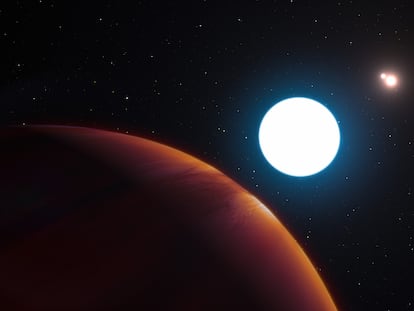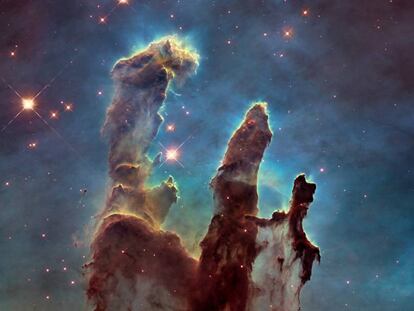Josep Maria Trigo, astronomer: ‘If a comet is coming, it doesn’t matter where we take shelter’
The specialist in asteroids and comets has just published ‘The Earth in Danger’ in a bid to help us understand the risk of impact

The Spanish astronomer Josep Maria Trigo, 52, is passionate about planetary defense, meaning the science and technology dedicated to preventing a space rock from handing us the same fate as the dinosaurs. Much of his passion is derived from the fact that he believes we are not prepared and that the population lacks information. Hence, his recent publication The Earth in Danger (Universitat de Barcelona Edicions), which warns about the risks he has been investigating as a researcher at the Institute of Space Sciences (CSIC) and the Institut d’Estudis Espacials de Catalunya.
Question. Is the Earth in danger?
Answer. We are exposed. But we have become accustomed to sensationalist headlines which are never accurate. Both the media and the scientists fail to explain the risk of impact in terms the general public can understand. When an asteroid approaches, typically, a news story crops up informing us that we could be hit, when we won’t be. However, small asteroids the size of the Chelyabinsk asteroid are out there and there could be one tomorrow. We’re not yet familiar with most of these objects measuring 10 to 20 meters and even up to 100 meters. Our current understanding is that large impacts will certainly not take place, but we are detecting a greater flux of impacts from 10 or 20 meter objects than was expected. We are discovering that these fragile bodies that break apart and pass close to Earth in an extremely close encounter can fall into Earth’s gravity well and, and if fragmented, fly off into very different orbits. Then the objects return to Earth at the same time. In the short and medium term, the danger comes from this type of object. That would explain, for example, how the asteroid Duende [discovered from Granada] grazed the artificial satellites the same day as Chelyabinsk [a meteor that entered the Earth’s atmosphere over the Ural mountains in Russia in 2013] took place. And although the orbits do not coincide at all, many of us think there is a correlation.
Q. And where do scientists come up short?
A. Scientists sometimes do not explain clearly enough that they are small bodies that are changing their orbits. The main mistake is to make people believe that we are well acquainted with the orbits of objects, when in fact we are obtaining information on orbits with an average level of precision. And when they come round again, we correct this. A clear example is Apophis, an asteroid that has been in the limelight but an impact from which has now been ruled out. This has to be explained to the public: when they are near-Earth asteroids, we do not do a continuous follow-up and there is a very important slant. I think the way we should explain this to the public is that we scientists have discovered this asteroid that will pass at such and such a distance and these objects are going to be tracked, and you can find more information on such and such websites. People should know that the media predicting impacts are not serious media.
Q. Are you more concerned about the ones that can produce a scare, like Chelyabinsk?
A. In Chelyabinsk, there were more than 1,500 wounded and that could have been avoided. If the same thing happens in a city like Madrid, Barcelona or New York, we could be talking about tens or hundreds of thousands of people injured. The risk is also the result of our ignorance. I mean, you see a huge fireball and you stand there looking at it. You have to inform people; you have to tell them that if you stay there, you will get severely burned. This is the kind of information that the media should be giving us, rather than telling us the sky is going to come crashing down.
If you see a huge fireball and you stand there looking at it, you will get severely burned
Q. What is the scenario that worries you most?
A. For me in particular, the asteroid 2015 TB145 made me shudder. It was an extinct, dark, 600-meter, extremely fast comet, discovered with three weeks to spare, which passed slightly farther from us than the Moon. And I think there may be quite a few more such objects. Jupiter plays a very important protective role in relation to Earth, with respect to perhaps the most dangerous impacts, which would be those of very non-concentric objects that are highly charged with energy. I am referring mainly to comets with very non-concentric orbits, that go beyond Jupiter’s orbit. These are extinct comets that come close to Earth perhaps every three, four or five years, and we don’t really see them because they’re tremendously dark. The 2015 TB 145 was a monster threatening at least regional-scale devastation. These are the ones that perhaps we should be most concerned about, because we are not acquainted with all of them. They are so obscure and non-concentric that there could be more.
Q. With an unlimited budget, how would you organize planetary defense?
A. With an array of telescopes in the Earth’s orbit working in the infrared range, where you see more than just reflected light, and you’re not bothered as much by stars and other background objects. It would be ideal to have an array of telescopes monitoring the sky to make the tracking more concrete. The key is always to have a solid prediction of when the impact is going to take place. Being acquainted with their movement, being able to study how they evolve, and extending that observation over months: that would provide a great deal of information on those processes that we are most in the dark about. Regarding Earth, I would install more radio telescopes the size of the one inaugurated in China. And of course, also, address the issue with space missions.
Q. Missions like DART, which is going to hit an asteroid?
A. This binary system that will intercept DART is a good example of the type of asteroids that reach us: Didymo is almost 780 meters and Dimorfo 160 meters, so they have the kind of dimensions that can worry us. To be able to study those two objects closely is a breakthrough, because the solution depends on the characteristics of each body. We have investigated asteroids like Ryugu and Bennu.
And those missions are key to mitigating any future risk of impact. In the case of Bennu, it has been shown to have a very low consistency on the surface, and to be more fragile than the wet sand that dries out when you build a sand castle on the beach. And these are good examples of the technological scientific challenge you face when you want to deflect an asteroid. Because sure, superficially it’s very fragile, but what’s inside? You could use a monolithic block, but of what dimensions? Such thin, porous material, which cushions any impact, indicates that this may not be the best solution.
We would have to consider other alternatives, but they involve knowledge decades in advance of the body’s orbit. You have to know that 50 years from now you have an asteroid that is heading for you so you can develop a mission that would have to be a collective mission of all the space agencies in unison. We are talking, obviously, about creating a monster that would stand next to the asteroid or land on it and alter its trajectory. Thanks to these missions that bring back asteroid samples, we are learning a lot more about their properties, which is very challenging, because they are not properties that we are familiar with.
The obscure extinct comets are the ones we should be most concerned about, because we are not acquainted with all of them
Q. Do you think there would be global unity in the face of a dangerous comet?
A. I think it would work well. I am convinced. There are clear examples that space agencies are working in continuous collaboration, and what happened in Russia has demonstrated that. A comet is very improbable; it could be a billion years away. But if it happens, faced with a challenge of that magnitude, it is clear that either we do it together, as one, or we don’t do it at all. Because it is not feasible for a single space agency to organize an impact mitigation process of that nature – whether it is a ship loaded with missiles or whatever you need to deal with such a monster. It has to be coordinated among the different agencies. We would need to seek alternatives, and maybe even set up two or three parallel options.
Q. It would take years of preparation.
A. With a small asteroid, no. Maybe with a mission like DART, which is fully robotic, it would go direct to its target. Having such a robot could be very useful for the future. But realistically, we would have to know the orbit of the asteroid years in advance. And we have major obstacles to overcome before we get there: we don’t have tracking programs from space that would allow us to improve our knowledge of the orbits. We lack radio telescopes to find out what these objects are really like. We have a long way to go. We have convinced the UN to implement Asteroid Day every year to raise awareness that we need to stay alert and expand our knowledge of these targets.
Q. And if we see a flare in the air, don’t stop to take a selfie.
A. It is important that the public is made aware that this is a latent danger. I try to stress that we rely on the historical record of humanity, but it is hugely biased. We don’t know of many incidents like this that have taken place in the past. Because our ancestors, faced with a Tunguska-type disruption, interpreted it in many other ways. And they certainly believed that it was divine intervention.
Q. Marian apparitions that were actually asteroids?
A. It has even been proposed that scripture’s Sodom and Gomorrah disasters were actually caused by an air burst. It may be that many of the occasions when it was believed the fire was raining down from the sky could have been an event like that. Recently, it was discovered that there are materials from what is thought to have been such an air burst in the Chilean desert. And in the Libyan desert, evidence was also found of an impact, or an air burst, as occurred at Tunguska. In these cases, when the fireballs hit the ground, everything is incinerated and the materials melted, leaving no evidence. This is another example of the bias that such an event can have.
Q. So maybe we have miscalculated the probabilities?
A. The impact risk has multiple heads, like Hydra. One is a direct impact with a Chicxulub-type asteroid, a 12-kilometer asteroid associated with the extinction of the dinosaurs. Another may be a Tunguska-style, which produces a shock wave and scatters trees over 2,000 square kilometers of taiga, which are incinerated when the fireball strikes. And others fall halfway between the two: objects of hundreds of meters that perhaps cause craters, because they are fragile, but that incinerate everything, triggering change on a regional scale. Sources of danger that perhaps we underestimate.
Q. Do you have nightmares about asteroids?
A. No, I’m quite relaxed in that sense. I enjoy studying them a lot, but I prefer not to think about those things. Because if it is discovered that a comet is coming, which is in effect a real chemical bomb, it doesn’t matter where we take shelter. We would face a global winter of unknown dimensions: weeks, months, years. So, why worry? Let’s hope it won’t happen for a long time, at least for thousands of years, by which time we will have small colonies on the Moon or Mars to ensure the survival of the species. It is a latent danger: if a large object were to hit us, it would completely wipe out our civilization.










































